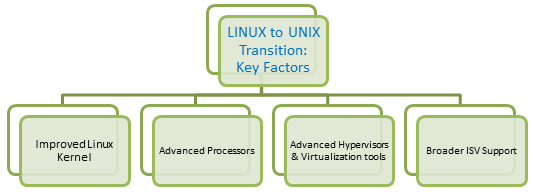UNIX to LINUX Migration Expected to Increase by 2017

With modernization at its heights, CIOs are doodling strategies to keep up with these transitions. If businesses do not step towards advancements, being backward will expose them to vulnerabilities, and they might be deprived of the right to stay potent in the market. Modernization deals with social changes from agricultural land to industrial ones, wherein innovative technologies play an indispensable role.
Where Mahindra and Mahindra is all set to launch its Kool Utility Vehicle (KUV) 100 cars in India, Seagate Technology plc (NASDAQ: STX) has recently launched its first 10TB enterprise capacity hard disk drive (HDD), and Uber has announced a new feature for developers called Uber Trip Experiences – seems like, every business tycoon is targeting to attract the attention of its users for better ROI and business throughput. This is what compelling CIOs to migrate from proprietary, closed architecture based on UNIX to the benchmarking open systems based upon x86 infrastructure.
Before we dig into details, let’s have a quick glance over the key factors driving quick Linux adoption:
Over the past few decades, IT organizations are continuously underpinned with financial pressures to cut down operational and capital expenses, all without sacrificing service levels. In this regard, it is measured that companies which migrated their core enterprise applications to open Red Hat Enterprise Linux (RHEL) have lowered down their total cost of ownership while gaining top of the line performance.
Reasons for Migrating to RHEL
There are a number of reasons that have fuelled up the Linux adoption rate.
- Linux provides additional capacity to meet changing business demands
- It helps in improvising business continuity by offering higher availability
- It helps businesses to align with their set objectives
Some of the Facts Supporting Linux Adoption: Gartner Study
Fact: By 2017, approximately 65% of core enterprise applications running on any of proprietary variants of UNIX operating systems in the year 2012 will be migrated to Linux based architecture, making IT planning inevitable.
Analysis: It was found that there are several factors that are outpacing UNIX anchor, irrespective of the fact that UNIX holds a great position after a major modernization or consolidation project. This growth is driven by emergence of Xeon-EX (7500 series) technology defining high-performance scalability. The other reason supported for Linux spread is – high level of logical scalability offered by the Linux kernel; improvisation of hypervisors and virtualization tools; and top of the line networking and clustering across several nodes.
Recommendation: It is recommended that businesses should not sanction more than 20% of their budget to UNIX with respect to IT procurement.
Fact: Linux scalability and reliability are the two major factors that will surpass UNIX by 2017; however the deployment pattern (scale-out cluster and fabric infrastructure) will continue to remain the same in 2017.
Analysis: It is expected that advantages of RISC/Itanium will fade away owing to fastest development cycle of the x86 platforms. In addition, enterprises like Red Hat, SUSE, and Oracle have shown how Linux is at par with UNIX in terms of features and functionalities. There is no denying the fact that RISC/Unix cannot be completely overshadowed, and it will be one of the prevalent technologies for other approaching years, however the presence of these technologies can be only witnessed in conventional data center setups. The new hyper-scale data centers Migration that are built, or are, currently, in the mid of the construction process will encompass high-tech, inexpensive and low-energy consuming blades.
Recommendation: Businesses looking forward for better returns should try to focus more on hard partitioning, high-end VM Hosting deployment and containers on Linux x86 environments. This approach will significantly help organizations to meet HA high-level database management systems and application consolidation, from 2015-2017.
THE BOTTOM LINE: Modernizing data center infrastructure is on the top priority list of CIOs initiatives. In line with this, moving UNIX based systems to Linux is a bountiful bet owing to its cost advantage which allows businesses to leverage private and public cloud deployments. The decision to utilize RHEL for critical business applications is not only strategic but also a financial decision. It is found that businesses that opted for this environment have gained maximum management benefits and business agility. On top of it, world will witness a great Linux adoption with the increase in the number of ERPs and DBMS users opting to switch from UNIX to Linux platform.
Looking forward to migrate your complex UNIX architecture to Linux environment? If yes, connect to our Linux support specialists right away at 1-800-212-2022.





